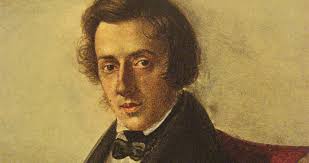"Tones sound, and roar and storm about me
until I have set them down in notes."
AUTHOR: Ludwig van Beethoven

MEANING OF THE QUOTE:

MEANING OF THE QUOTE:
COMPOSER:
FREDERIC CHOPIN

FREDERIC CHOPIN
ETUDE IN C-MINOR OP. 10, NO. 12
REVOLUTIONARY (1831)
REVOLUTIONARY (1831)
"FALL OF WARSAW"

ETUDE IN C-MINOR OP. 10, NO. 12
REVOLUTIONARY (1831)
"FALL OF WARSAW"
Chopin was inspired to write this piece,
initially called the Étude on the Bombard-
ment of Warsaw, during his Polish homeland's
unsuccessful revolution against Russia
after the Russian attack on Warsaw during
An etude is a French word for a musical
study piece (short composition) for a solo
instrument designed to provide practice
material for perfecting a particular musical
skill. It is intended to demonstrate
technical virtuosity; a musical exercise.
| Russian assault on Warsaw in 1831 |
The Battle of Warsaw was fought in
September 1831 between Imperial Russia
and Poland; a Polish rebellion that un-
successfully tried to overthrow Russian rule
in the Congress Kingdom of Poland as well
as in the Polish provinces of western Russia
and Ukraine. After a two-day assault of the city's
western fortifications, the Polish defenses
collapsed and the city was evacuated. It was
the largest battle of the Polish-Russian War of
1830–1831 and the final episode of what
became known as the November Uprising.
 |
| Emila Plater Conducting Polish Scythemen in 1831 |
Due to poor health Chopin could not fight
for his beloved country so he wrote
for his beloved country so he wrote
this music as a tribute instead.
ETUDE IN C-MINOR OP. 10, NO. 12
REVOLUTIONARY (1831)
"FALL OF WARSAW"
Sviatoslav Richter, Piano
| Marcin Zaleski: Capture of the Arsenal in Warsaw 1830 |
ETUDE IN C-MINOR OP. 10, NO. 12
REVOLUTIONARY (1831)
"FALL OF WARSAW"
Ignace Paderewski, Piano
Together with the radio interview of Ignaz Friedman,
speaking on Paderewski, in 1940.
 |
| Juliusz Kossak: Battle of Ostrołęka, 1831 |
the last in his first set, Etudes Op.10,
dedicated "à son ami Franz Liszt"
("to his friend Franz Liszt").
 |
Franz Liszt in his
Travelling Coat
|
Chopin often used his music to pour his
emotions out on the matter of the suppression
emotions out on the matter of the suppression
of the Polish people by the Russians.
 |
| Karol Malankiewicz: 1831 Battle of Ostroleka, 1828 |
During this time period he produced some of
his darkest and most passionate works
such as the Scherzo No. 2
his darkest and most passionate works
such as the Scherzo No. 2
SCHERZO NO. 2
IN B-FLAT MINOR,
OP. 31 (1837)
and this etude which expressed the
strong feelings that emerged in him
after hearing of Poland's failure
in its rebellion against them.
strong feelings that emerged in him
after hearing of Poland's failure
in its rebellion against them.
 |
| Juliusz Kossak: Charge of Poznań Cavalery During November Uprising |
"All this has caused me so much pain.
Who could have foreseen it!"
 |
| Kingdom of Poland 1830-1831 |
The "Revolutionary Étude" holds its place as
one of the most eminent and well recognized
one of the most eminent and well recognized
of all of Chopin’s compositions.
In the beginning, after a strong dramatic first
chord rings out, perhaps likening the opening
chord rings out, perhaps likening the opening
chord to a gunshot, the ensuing tumultuous left
hand, playing low notes, runs relentlessly
(the technical difficulty is in the left hand

having rapid runs and frequent turns
including poly-rhythms and cross-rhythms)
giving the piece a sullen, dramatic

having rapid runs and frequent turns
including poly-rhythms and cross-rhythms)
giving the piece a sullen, dramatic
theme; a sense of chaos or war.
 |
| Battle of Iganie: April 10, 1831 |
Above it is added the impassioned melody in the
right hand which could be interpreted as
a hero fighting a battle in a war.
 |
Wojciech Kossak: A Night of November
A Scene from the November Insurrection of 1830-1831
|
The higher notes are a nice change in
the song, offering a glimpse of hope during a
time of such despair for the Polish people
although this is quickly shot down with the
sad sounds of the lower notes. Alternating the high
and low notes increases the drama in the song.
 |
| Battle of Bialoleka: February 25, 1831 |
Another technique to note is the sporadic playing
of piano notes. The song doesn't repeat a measure
once which adds to the sense of chaos.
of piano notes. The song doesn't repeat a measure
once which adds to the sense of chaos.
 |
| Jan Rosen: Battle of Stoczek, 1831 |
written during the Romantic era which
experienced stylistic changes in music chang-
ing to emotional writing instead of writing
for patrons (moving from order and rules,
as seen in the Baroque and Enlightenment
periods, to Romantic spontaneity).
REVOLUTIONARY ETUDE
SHEET MUSIC






After a hard struggle, the piece ends quite as
chaotically and dramatically as it started, yet in C-
chaotically and dramatically as it started, yet in C-
major in stead of the stormy key of C minor in which
it began, leaving us with a sense of ambiguity; we
are not sure if our hero prevailed or perished,
but we do know that he fought bravely
with both body and spirit.
LINKS
